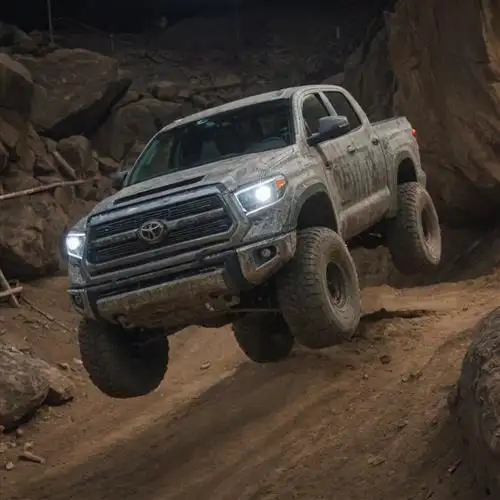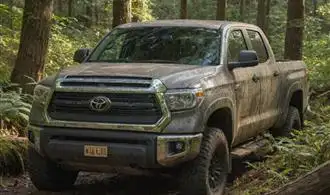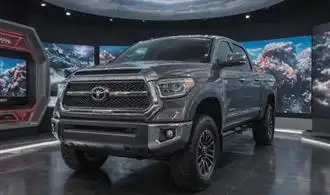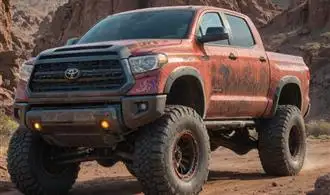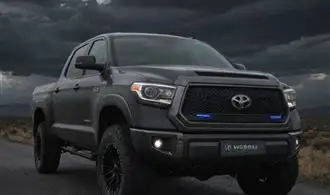
Towing Capacity Limitations
The Toyota Tundra is a formidable pickup truck with impressive capabilities, but its towing capacity is not without limitations. It's crucial for Tundra owners to understand these limitations to ensure they use their vehicle safely and effectively.
One of the primary factors that determine a Tundra's towing capacity is the model year and configuration. Newer Tundra models generally have higher towing capacities, with the latest versions boasting a maximum towing capacity of up to 12,000 pounds. However, older models or specific configurations may have lower towing capacities, sometimes as low as 6,800 pounds. It's essential to refer to the vehicle's owner's manual or consult with a Toyota dealer to determine the precise towing capacity for your Tundra.
The Tundra's payload capacity is another critical factor to consider when towing. The payload capacity, which is the maximum weight the truck can safely carry, including passengers, cargo, and the trailer tongue weight, is limited. Overloading the Tundra can compromise its handling, braking, and overall performance, potentially leading to dangerous situations on the road.
Additionally, the type of trailer being towed can also impact the Tundra's towing capacity. Lighter, more aerodynamic trailers generally allow for higher towing capacities, while larger, heavier trailers may require a different truck or additional equipment to tow safely.
- Know the specific towing capacity of your Tundra model and configuration
- Carefully calculate the total weight of the trailer, cargo, and passengers to avoid exceeding the payload capacity
- Consider the type and size of the trailer and ensure it's compatible with the Tundra's towing capabilities
- Regularly maintain the Tundra and any towing equipment, such as the hitch and trailer brakes, to ensure optimal performance and safety
- Drive cautiously and adjust your driving style when towing to account for the added weight and length of the trailer
Fuel Economy Realities
As a Toyota Tundra owner, managing fuel economy can be a delicate balance. While this full-size pickup offers impressive power and capability, its sheer size and weight can impact gas mileage. Understanding the realities of Tundra fuel economy is crucial for setting realistic expectations and making informed decisions.
The EPA-estimated fuel economy for the Tundra varies depending on the engine, drivetrain, and other factors, but generally falls within the range of 13-18 miles per gallon in the city and 17-22 miles per gallon on the highway. However, real-world driving conditions can significantly affect these numbers. Factors such as driving style, payload, towing, terrain, and weather can all influence the Tundra's fuel efficiency.
Tundra owners who frequently tow heavy loads or operate in mountainous regions may experience lower fuel economy, often dipping into the low to mid-teens. Conversely, those who primarily use their Tundra for city driving or light-duty hauling may see fuel economy numbers closer to the upper end of the EPA estimates.
- Maintain proper tire inflation pressure
- Avoid aggressive acceleration and braking
- Use the recommended fuel grade
- Remove unnecessary cargo and accessories when not in use
- Plan routes to minimize unnecessary idling and stop-and-go driving
- Consider the use of fuel-saving technologies like auto start-stop systems
Maintenance Costs Over Time
As Toyota Tundra owners, it's crucial to understand the long-term maintenance costs associated with this versatile pickup truck. While the Tundra is renowned for its reliability and durability, regular maintenance is key to keeping it running smoothly and efficiently over the years.
One of the primary maintenance expenses Tundra owners can expect is the periodic need for oil changes. Depending on your driving habits and conditions, oil changes may be required every 5,000 to 10,000 miles. The cost of these oil changes can range from $30 to $100, depending on the type of oil used and the labor involved.
Tire maintenance is another significant expense for Tundra owners. The large, off-road-capable tires on the Tundra can be more expensive to replace than standard passenger vehicle tires. Expect to pay anywhere from $150 to $300 per tire, depending on the brand and size.
Brake maintenance is another important consideration. Over time, the brake pads and rotors on the Tundra will need to be replaced. This can typically cost between $300 and $600, depending on the specific parts needed and the labor required.
Owners should also be prepared for potential issues with the Tundra's transmission. While the Tundra is known for its reliable transmission, major repairs or replacements can be costly, ranging from $1,500 to $3,000 or more.
Additionally, the Tundra's large size and off-road capabilities may result in increased fuel consumption compared to smaller, more fuel-efficient vehicles. Owners should factor in the cost of fuel, which can vary significantly depending on the local market and driving conditions.
Ride Quality on Uneven Terrain
The Toyota Tundra is a popular full-size pickup truck known for its impressive capabilities and durability. However, one aspect that Tundra owners often wish they had known more about is the ride quality on uneven terrain. The Tundra's suspension system is designed to provide a comfortable ride on paved roads, but navigating rough, off-road conditions can present a unique set of challenges.
One of the primary factors that affects the Tundra's ride quality on uneven terrain is the truck's wheelbase. The Tundra's long wheelbase, which is necessary for its impressive payload and towing capacity, can make it more susceptible to pitching and bouncing over uneven surfaces. This can lead to a less-than-smooth ride, particularly when traversing rocky, rutted, or hilly off-road trails.
Another key consideration is the Tundra's suspension setup. The truck's front suspension utilizes a double-wishbone design, which is generally well-suited for on-road performance. However, this setup may not provide the same level of articulation and wheel travel as some other off-road-focused suspension systems. This can result in the Tundra feeling less composed and stable when navigating challenging terrain.
To address these issues, many Tundra owners choose to upgrade their suspension components, such as installing aftermarket shocks or lift kits. These modifications can help improve the truck's off-road capabilities and provide a smoother ride on uneven surfaces. However, it's important to note that these upgrades may also affect the Tundra's on-road handling and ride quality, so it's crucial to find the right balance between on-road and off-road performance.
Additionally, the Tundra's tire choice can significantly impact its ride quality on uneven terrain. Larger, more aggressive off-road tires can provide better traction and suspension compliance, but they may also produce a rougher ride on paved roads. Owners should carefully consider their driving needs and terrain preferences when selecting the appropriate tire setup for their Tundra.
Resale Value Considerations
As a Toyota Tundra owner, understanding the vehicle's resale value is crucial when planning for the long-term ownership experience. The Tundra is renowned for its exceptional durability and reliability, but several factors can influence its resale value over time. By being aware of these considerations, Tundra owners can make informed decisions and potentially maximize the return on their investment.
One of the primary factors that affect the Tundra's resale value is the vehicle's mileage. Trucks with lower odometer readings tend to retain their value better than those with higher mileage. Tundra owners who use their vehicles primarily for light-duty tasks, such as commuting or occasional hauling, may see a higher resale value compared to those who subject their trucks to heavy-duty use, such as frequent towing or off-road adventures.
Condition is another critical factor. Tundras that have been well-maintained, with regular servicing and minimal cosmetic damage, will typically command a higher price in the used car market. Owners who meticulously care for their Tundras, both inside and out, can expect a more favorable resale value when the time comes to sell or trade-in the vehicle.
The Tundra's trim level and options package can also play a significant role in its resale value. Higher-end trims, such as the Limited or Platinum models, tend to hold their value better than the base SR or SR5 trims. Additionally, Tundras equipped with desirable features, such as a premium audio system, advanced safety technologies, or a sunroof, may fetch a higher price compared to more basic configurations.
Another factor to consider is the overall demand for the Toyota Tundra in your local market. Regions with a higher preference for full-size trucks may see stronger resale values compared to areas where smaller or mid-size pickup trucks are more prevalent. Understanding the local market trends can help Tundra owners make informed decisions about the optimal time to sell or trade-in their vehicle.




